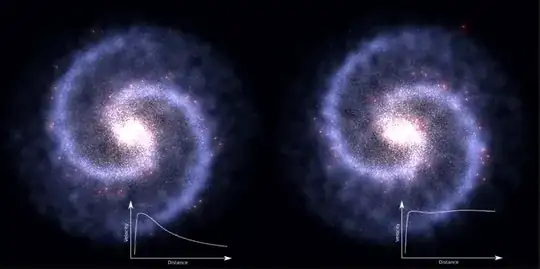Let's first have a look at the observed speed within galaxies (source):

On the left side we can see the speed of celestial bodies within galaxies derived by gravity only (gravity is usually created by a black hole at the center of a galaxy), on the right side we can see the observed speed of celestial bodies, both in respect of the distance from the galactic center.
As a result, the strength of dark matter (or "space force") could be calculated as:
$F$dark matter = $m$galaxy $\cdot$ $v$celestial body within galaxy $\frac{d}{dt}$ - $g$black hole, center of galaxy
Is this a viable calculation? And if so, are there any a graphs online which show this strength of dark matter (or "space force") in respect of the distance from the galactic center?
(Note: In this formula, a galaxy would be assigned a mass $m$galaxy much higher than the mass of its black hole. However, mathematically speaking one could also just decrease $dt$, so with a celestial body wandering from the center to the outskirts of the galaxy, $dt$ would decrease, hence the speed of time would increase. I doubt this is true because it would change the basic definition of speed $v$celestial body within galaxy as well and introduce all kinds of illogical contradictions, but in math everything is possible as we know from theory of relativity...)
Addendum:
- $m$galaxy $\cdot$ $v$celestial body within galaxy $\frac{d}{dt}$ $[kg·\frac{m}{s^2}]$ = observable force (shown in picture on the right)
- $g$black hole, center of galaxy $[kg·\frac{m}{s^2}]$, the force caused by gravity of a black hole (shown in picture on the left)
- $F$dark matter $[kg·\frac{m}{s^2}]$, the force of dark matter up until a point in space